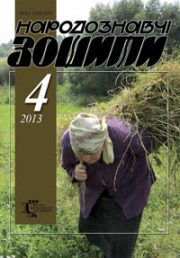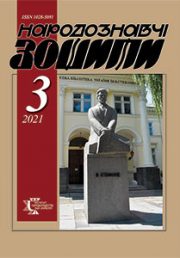2020 #4 Triska O.
The Ethnology Notebooks. 2020. № 4 (154), 806—818
UDK [75.04.05.011.26:27-526.62:398.34](=161.2)”199/201”
DOI https://doi.org/10.15407/nz2020.04.806
IN SEARCH OF NEW MEANINGS: TRADITIONS AND INNOVATION IN ICONS FOR HOMES
TRISKA Oksana
- ORCID ID: https://orcid.org/0000-0002-4717-4396
- Ph.D, Art History Researcher at Folk Art
- Department of Ethnology Institute
- of the National Academy of Sciences of Ukraine,
- 15, Svobody ave., 79000, Lviv, Ukraine,
- Contacts: e-mail: oksana_triska@yahoo.de
Abstract. An important genre of religious painting is iconography, designed for non-liturgical space. Numerous Ukrainian artists, both professional and amateur, work in this direction, but their work is not covered in art history very well. The novelty of the article is the introduction into scientific circulation of a new layer of works that expand and diversify the scope of life of the home icon. The object of the research are the processes of making icons for homes, the subject – the works of 1990—2019, created on the basis of implementing the traditions of folk icon painting. The purpose of the article is to identify current changes and trends in the field of icon painting and to clarify modern models of interpretation of traditional household practices. To do this, it is necessary to use historical-comparative and formal-stylistic methods that allow to consider the longevity of tradition in a cultural context.
Artists develop three areas of home icon painting: making copies of ancient icons, interpretive and authorial works. The article analyzes the first two groups that emerged because of imitation or under the influence of folk images of Bukovyna, Hutsulshchyna and Pokuttya and, in part, church models. In the creative process, borrowing certain iconographic, stylistic or technological elements for a particular icon plays an important role.
One of the main elements that were borrowed is planar-decorative stylistics and different types of ornamental motifs is great associative similarity with the images of the late nineteenth and early twentieth centuries that is provided by imitation of color. By popularizing ancient iconographic schemes, the authors add new topics to iconography. One of the brightest ways of doing that is to create family icons with numerous security cartridges. The peculiarity of such innovation is the interpretation of plots by means of icon painters of past centuries.
For the first time, the study combines different style researches of Lviv icon painters who work on the basis of one ethnocultural tradition. Authors O. Vynnychok, O. and M. Hnativ, R. Zilinko, O. Lozynsky, U. Nyschuk and others actualize the monuments of antiquity, draw attention to the artistic heritage of Ukraine and offer contemporaries a rich selection of home images with preserved ethnocolor.
Keywords: non-liturgical space, folk art, home icon, iconography, stylistic features, author’s copy, mixed stylistics, home and church icon painting.
Received 29.05.2020
REFERENCES
- Tsuhorka, O.P. (2016). Sacred art of painting: domestic scientific reflection. Bulletin of the National Academy of Management of Culture and Arts, 4, 115—118 [in Ukrainian].
- Dymyd-Krypyakevych, I. «The icon is my language in which I glorify God». January 4, 2008. Retrieved from: https://risu.org.ua/ua/index/exclusive/events_people/20076/ [in Ukrainian].
- Klyuchkovska, I. Roman Vasylyk. Path to the icon. Retrieved from: https://risu.org.ua/page.php?_lang=ua&path=monitoring/&name=kaleido_digest&id=45524&alias=& [in Ukrainian].
- Voloshyn, L. (2012). The interpretation of the sacral art traditions in the works of Kost’ Markovych. Visnyk Lvivskoi natcionalnoi akademii mustectv, 23, 272—279 [in Ukrainian].
- Triska, O. (2018). The tradition of the domestic icon on glass: revival, interpretation (on the example of the Lviv center). The Ethnology notebooks, 2, 363—371 [in Ukrainian].
- Folk icon // https://www.facebook.com/pg/narodna.ikona/photos/?ref=page_internal
- Sventsitska, V. (1990). Radiant colors of «red images» of the Hutsul region. Dzvin, 12, 140—146 [in Ukrainian].
- Turianska about Turianska. 26 of May 2020 // https://mitec.ua/turyanskaproturyansku/?fbclid=IwAR2oTZAHRasjES2r2RzuNU5CFp7Cdh24K_qrJpFQq5IaHPWoBcPcCZKJFU0 [in Ukrainian]
- Romaniv-Triska, O. (2008). Western-Ukrainian painting on glass of the XIX — first third of the XX century. Folk icon on glass (Pp. 13—33), Lviv [in Ukrainian].
- Sventsitska, V.I., & Otkovich, V.P. (1991). Ukrainian folk painting of the XIII—XX centuries. Album. Kyiv: Art [in Ukrainian].
- Hierodeacon Januariy (Honchar), & Vyacheslav, Shulika (2019). Ukrainian icon. Borysivka settlement of the late XIX — early XX centuries, Kyiv: Ivan Honchar Museum [in Ukrainian].
- Roman Zilinko and his warm icons. Retrieved from: https://korali.info/usna-tvorchist/roman-zilinko-ta-iogo-tepli-ikoni.html?fbclid=IwAR16a67bhuXkQxa-BQlza8b0feBuk_maLX61LHpj_y9oQ [in Ukrainian].






